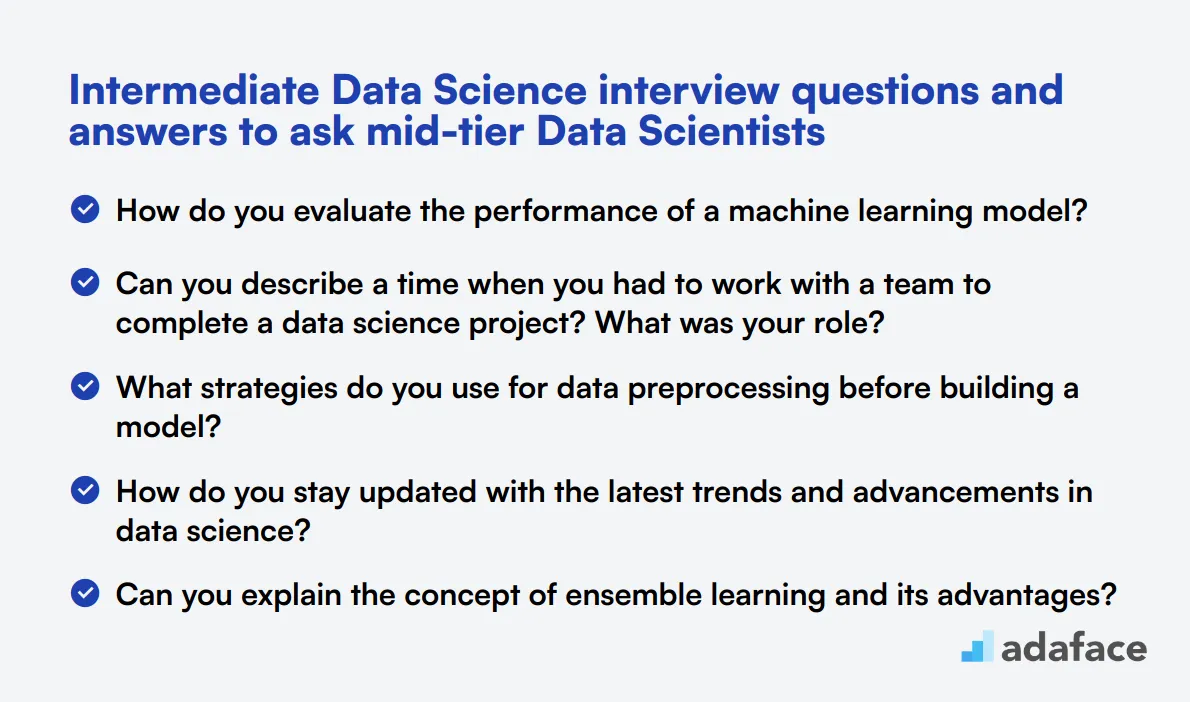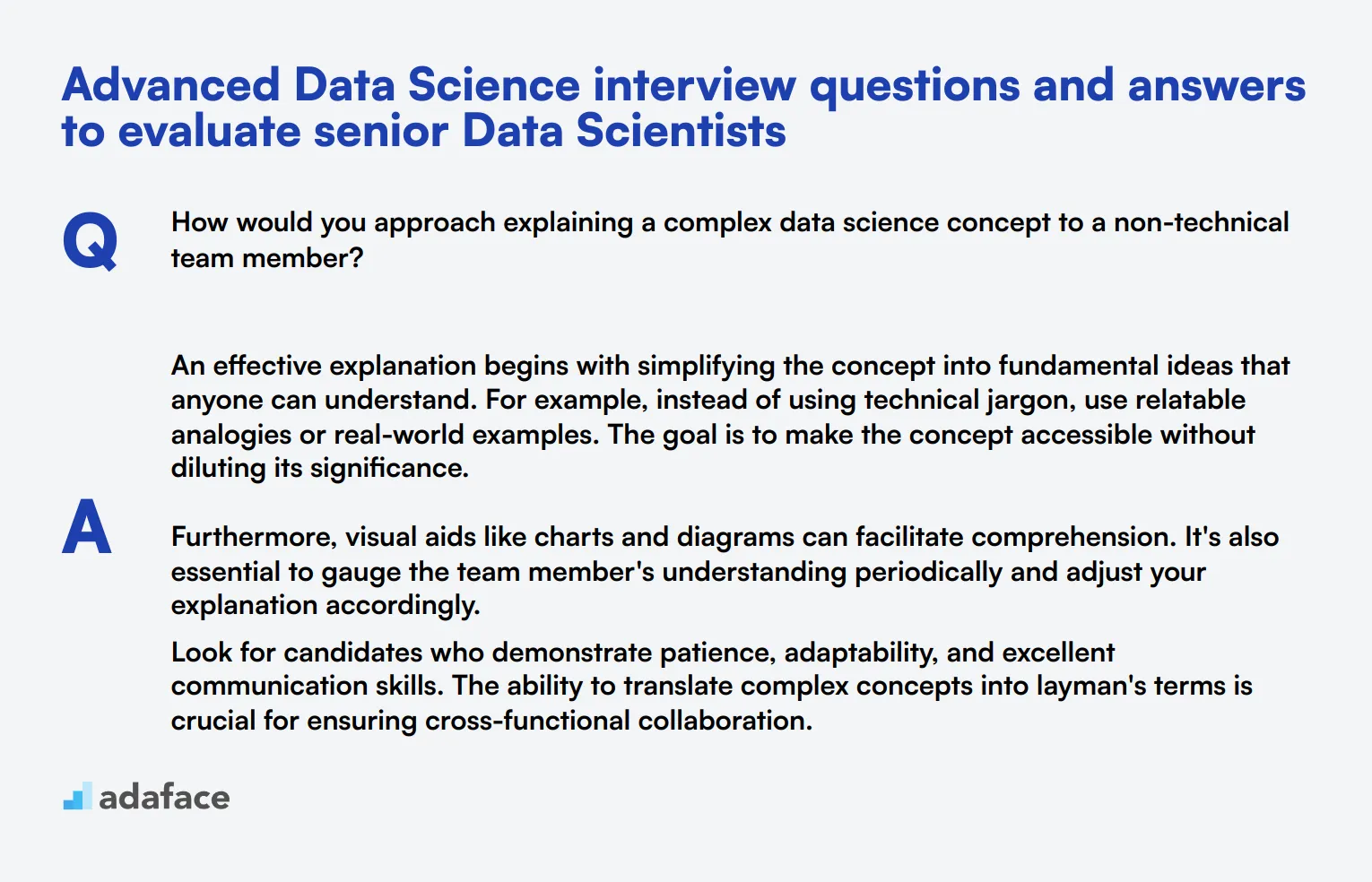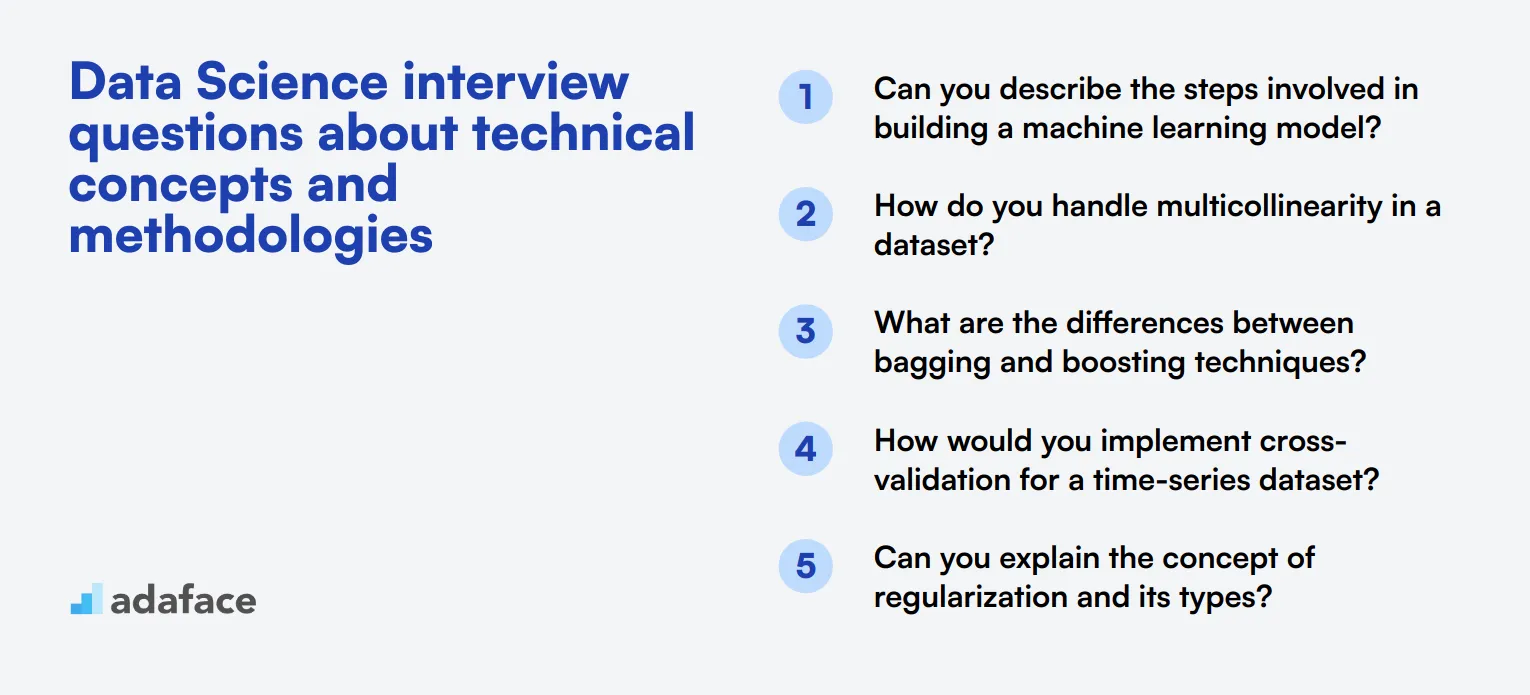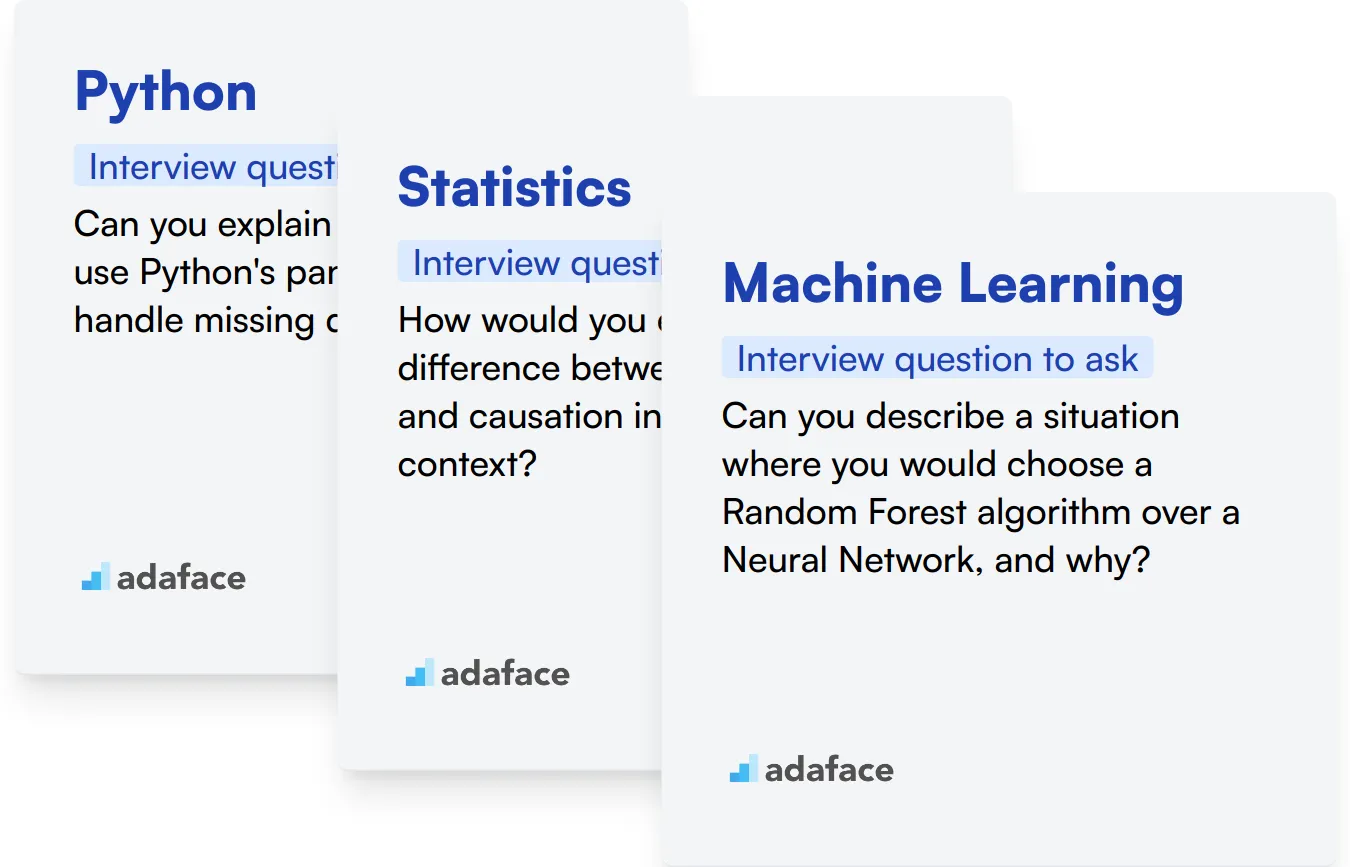Conducting interviews for Data Science roles can be daunting, especially given the technical depth and breadth of the field. Hiring the right candidate ensures your business leverages data effectively and maintains a competitive edge, as outlined by the key skills required for a data scientist.
In this post, we provide a range of Data Science interview questions tailored to different experience levels, from junior to senior candidates. We’ve also included questions focused on technical concepts and methodologies to give you a comprehensive toolkit for your interviews.
Using these questions, you can better evaluate candidates' expertise and fit for the role. To further streamline your hiring process, consider using our Data Science Test before conducting interviews.
Table of contents
10 common Data Science interview questions to ask your applicants

To effectively evaluate your applicants' proficiency in Data Science, consider using these common interview questions. They will help you identify whether candidates possess the necessary skills and knowledge required for the role. For detailed insights into a Data Scientist's responsibilities, you can refer to data scientist job description.
- Can you explain a data science project you have worked on from start to finish?
- How do you handle missing or inconsistent data in a dataset?
- What is overfitting, and how can you prevent it?
- Can you explain the difference between supervised and unsupervised learning?
- How do you choose the right algorithm for a particular problem?
- What are some methods you use for feature selection?
- What is the significance of cross-validation in model building?
- Can you discuss a challenging data science problem you have encountered and how you solved it?
- How do you communicate your findings and insights to non-technical stakeholders?
- What tools and programming languages are you most comfortable with in data science?
8 Data Science interview questions and answers to evaluate junior Data Scientists

Ready to put your junior Data Scientists through their paces? These eight questions will help you evaluate their fundamental knowledge and problem-solving skills. Use them to gauge candidates' understanding of key concepts and their ability to apply data science principles in real-world scenarios. Remember, the goal is to assess potential, not just current expertise!
1. Can you explain the concept of dimensionality reduction and why it's important in data science?
Dimensionality reduction is a technique used to reduce the number of features in a dataset while retaining as much of the important information as possible. It's crucial in data science for several reasons:
• Improves model performance by reducing noise and overfitting • Speeds up computation time • Helps with data visualization by reducing dimensions to 2D or 3D • Addresses the 'curse of dimensionality' in high-dimensional datasets
Look for candidates who can explain the concept clearly and provide examples of dimensionality reduction techniques like PCA or t-SNE. Strong answers will also touch on the trade-offs between information loss and computational efficiency.
2. How would you approach a time series forecasting problem?
A solid approach to time series forecasting typically involves the following steps:
- Data exploration and visualization to understand patterns, trends, and seasonality
- Data preprocessing, including handling missing values and outliers
- Decomposing the time series into trend, seasonal, and residual components
- Selecting appropriate models (e.g., ARIMA, Prophet, or LSTM)
- Training the model and tuning hyperparameters
- Evaluating model performance using metrics like RMSE or MAPE
- Making predictions and assessing forecast uncertainty
Pay attention to candidates who mention the importance of data preprocessing and model selection based on the specific characteristics of the time series. Strong answers will also discuss the challenges of time series data, such as autocorrelation and non-stationarity.
3. What is the difference between correlation and causation? Can you provide an example?
Correlation refers to a statistical relationship between two variables, indicating that they tend to change together. Causation, on the other hand, implies that changes in one variable directly cause changes in another.
A classic example is the correlation between ice cream sales and drowning incidents. While there's a positive correlation between the two, ice cream sales don't cause drownings. Instead, both increase during summer months due to warmer weather.
Look for candidates who can clearly distinguish between the two concepts and provide their own examples. Strong answers will also mention the phrase 'correlation does not imply causation' and discuss methods for establishing causality, such as randomized controlled trials or natural experiments.
4. How would you detect and handle outliers in a dataset?
Detecting and handling outliers is a crucial step in data preprocessing. Some common methods for outlier detection include:
• Statistical methods: Z-score, IQR (Interquartile Range) • Visualization techniques: Box plots, scatter plots • Machine learning approaches: Isolation Forest, Local Outlier Factor
Once detected, outliers can be handled by: • Removing them if they're due to errors • Transforming the data (e.g., log transformation) • Capping at a certain value (winsorization) • Using robust statistical methods that are less sensitive to outliers
Evaluate candidates based on their understanding of different detection methods and their ability to explain when and why to use each approach for handling outliers. Strong answers will also consider the impact of outlier treatment on the overall analysis.
5. Can you explain the bias-variance tradeoff in machine learning?
The bias-variance tradeoff is a fundamental concept in machine learning that describes the relationship between a model's complexity and its performance on training and test data.
• Bias: The error introduced by approximating a real-world problem with a simplified model. High bias can lead to underfitting. • Variance: The model's sensitivity to small fluctuations in the training data. High variance can lead to overfitting.
Look for candidates who can explain that increasing model complexity typically reduces bias but increases variance, and vice versa. Strong answers will discuss how this tradeoff affects model selection and the importance of finding the right balance to achieve optimal performance on unseen data.
6. How would you handle imbalanced datasets in classification problems?
Handling imbalanced datasets is crucial for building effective classification models. Some common approaches include:
- Resampling techniques: • Oversampling the minority class (e.g., SMOTE) • Undersampling the majority class • Combination of both (e.g., SMOTEENN)
- Algorithmic approaches: • Using algorithms that handle imbalance well (e.g., decision trees) • Adjusting class weights
- Ensemble methods: • Bagging, boosting with a focus on minority class
- Changing the performance metric: • Using F1-score, ROC AUC, or precision-recall curve instead of accuracy
Evaluate candidates based on their understanding of different techniques and their ability to explain when to use each approach. Strong answers will also discuss the importance of choosing appropriate evaluation metrics for imbalanced datasets.
7. What is the difference between parametric and non-parametric models?
Parametric models assume a specific functional form for the relationship between features and target variable, with a fixed number of parameters. Examples include linear regression and logistic regression. Non-parametric models, on the other hand, don't make strong assumptions about the form of the mapping function and can flex their complexity as needed. Examples include decision trees and k-nearest neighbors.
Key differences: • Parametric models are typically simpler and faster to train • Non-parametric models can capture more complex relationships but may require more data • Parametric models are more interpretable, while non-parametric models can be seen as 'black boxes'
Look for candidates who can explain these differences clearly and provide examples of each type of model. Strong answers will also discuss the trade-offs between the two approaches and when to use each in real-world scenarios.
8. How would you approach feature engineering for a machine learning project?
Feature engineering is the process of creating new features or transforming existing ones to improve model performance. A good approach typically involves:
- Understanding the domain and problem
- Exploring the data to identify patterns and relationships
- Creating new features based on domain knowledge
- Transforming existing features (e.g., log transformation, binning)
- Encoding categorical variables
- Handling temporal and spatial data
- Feature selection to identify the most relevant features
Evaluate candidates based on their ability to explain the importance of feature engineering and provide specific examples of techniques they've used. Strong answers will also discuss the iterative nature of feature engineering and its impact on model performance.
15 intermediate Data Science interview questions and answers to ask mid-tier Data Scientists

To assess whether candidates possess the necessary skills and experience for mid-tier data science roles, utilize this set of targeted interview questions. These inquiries will help you gauge their technical knowledge and real-world application in data science. For more detailed insights on related roles, feel free to explore our data scientist job description.
- How do you evaluate the performance of a machine learning model?
- Can you describe a time when you had to work with a team to complete a data science project? What was your role?
- What strategies do you use for data preprocessing before building a model?
- How do you stay updated with the latest trends and advancements in data science?
- Can you explain the concept of ensemble learning and its advantages?
- What is the purpose of feature scaling, and how do you implement it?
- How would you approach the problem of model interpretability?
- What are some common pitfalls in data science projects that you have encountered?
- Can you discuss a specific algorithm you prefer and why?
- How do you prioritize tasks when working on multiple data science projects simultaneously?
- What role does data visualization play in your work, and what tools do you use?
- How would you ensure the reproducibility of your data science experiments?
- Can you describe how you would implement A/B testing in a project?
- What is your experience with cloud services in data science, and how have they impacted your work?
- How do you handle feedback or criticism on your data science work?
9 advanced Data Science interview questions and answers to evaluate senior Data Scientists

To evaluate senior Data Scientists, it's essential to ask questions that go beyond the basics and delve into their advanced knowledge and problem-solving capabilities. This list of advanced interview questions will help you identify candidates who can tackle complex data science challenges and drive your projects to success.
1. How would you approach explaining a complex data science concept to a non-technical team member?
An effective explanation begins with simplifying the concept into fundamental ideas that anyone can understand. For example, instead of using technical jargon, use relatable analogies or real-world examples. The goal is to make the concept accessible without diluting its significance.
Furthermore, visual aids like charts and diagrams can facilitate comprehension. It's also essential to gauge the team member's understanding periodically and adjust your explanation accordingly.
Look for candidates who demonstrate patience, adaptability, and excellent communication skills. The ability to translate complex concepts into layman's terms is crucial for ensuring cross-functional collaboration.
2. Can you describe a scenario where you had to choose between precision and recall in your model? How did you make that decision?
Precision and recall are crucial metrics, and the choice between them depends on the specific context of the problem. For instance, in a medical diagnosis system, recall (identifying all true positives) might be prioritized to ensure that no potential cases are missed, even if it means having some false positives.
Conversely, in a spam detection system, precision might be more critical to avoid marking legitimate emails as spam. The decision involves understanding the trade-offs and the impact of false positives and false negatives in the given context.
Ideal candidates should demonstrate a strong understanding of these metrics and provide a clear, context-driven rationale for their decision. They should also be able to discuss the implications of their choice on the overall system performance.
3. How do you ensure the reproducibility of your data science experiments?
Reproducibility is fundamental for verifying results and building upon previous work. To ensure reproducibility, it's essential to maintain clear documentation of the data sources, preprocessing steps, and model parameters used in the experiments.
Using version control systems like Git to track changes in the codebase and data versions can also help. Additionally, containerization tools like Docker can create consistent environments that replicate the experiment setup across different systems.
Recruiters should look for candidates who emphasize meticulous documentation and the use of version control and containerization. These practices are vital for collaboration and long-term project success.
4. What strategies do you use to handle imbalanced datasets?
Imbalanced datasets can skew model performance. One strategy is to use techniques like oversampling the minority class or undersampling the majority class to balance the dataset. For instance, the SMOTE (Synthetic Minority Over-sampling Technique) algorithm can generate synthetic samples of the minority class.
Another approach is to use different evaluation metrics such as F1 score, precision-recall curves, or area under the precision-recall curve instead of accuracy. Additionally, algorithms like ensemble methods can be tailored to handle class imbalance better.
Candidates should demonstrate a thorough understanding of these techniques and provide examples of how they've successfully applied them in past projects. Their ability to choose and justify the right strategy based on the specific context is key.
5. How do you identify and mitigate bias in a machine learning model?
Identifying bias starts with understanding the data and the context in which the model will be used. Exploratory data analysis can reveal potential biases in the dataset, such as overrepresentation of certain groups.
Mitigation strategies include techniques like re-sampling the data, using fairness-aware algorithms, and incorporating domain knowledge to adjust the model. Continuous monitoring of the model's performance across different subgroups is also essential.
Look for candidates who can discuss specific examples of bias they've encountered and how they addressed it. Their approach should reflect a commitment to ethical AI and fairness in their models.
6. Can you explain a situation where you had to work with unstructured data? How did you handle it?
Unstructured data, such as text, images, or audio, presents unique challenges. The first step is usually to preprocess the data, which could involve techniques like tokenization for text data or feature extraction for images.
For example, in a text analysis project, you might use natural language processing (NLP) techniques to convert text into structured formats like word embeddings. Tools and libraries like NLTK or spaCy can be invaluable in this process.
Candidates should demonstrate their experience with specific tools and techniques for handling unstructured data. Their ability to preprocess and extract meaningful features from such data is crucial for building effective models.
7. Describe a time when you had to update a deployed model. What steps did you take to ensure a smooth transition?
Updating a deployed model involves several steps to ensure continuity and accuracy. Firstly, it's important to validate the new model thoroughly using a holdout dataset or cross-validation to ensure it performs better than the current one.
Next, deploying the new model in a staged manner, initially in a testing environment and gradually in production, can help catch any unforeseen issues. Monitoring the model's performance post-deployment is also essential to quickly address any discrepancies.
Recruiters should look for candidates who emphasize rigorous validation and careful deployment strategies. Their approach should minimize disruptions and ensure the reliability of the updated model.
8. How do you stay updated with the latest trends and advancements in data science?
Staying updated is crucial in the rapidly evolving field of data science. Regularly reading research papers, attending conferences, and participating in webinars are some effective ways to keep abreast of the latest developments.
Additionally, engaging with the data science community through platforms like GitHub, Stack Overflow, or specialized forums can provide valuable insights and foster continuous learning.
Ideal candidates should demonstrate a proactive approach to learning and staying updated. Their engagement with the community and dedication to professional development are key indicators of their commitment to the field.
9. What is your approach to feature engineering in a machine learning project?
Feature engineering involves creating new features from raw data that better represent the underlying problem to the model. This process can significantly impact the model's performance. Techniques might include aggregation, normalization, and creating interaction terms.
For example, in a retail sales prediction task, creating features like 'month-over-month sales growth' or 'holiday season indicator' can provide additional context. Domain knowledge plays a crucial role in identifying meaningful features.
Candidates should illustrate their methodical approach to feature engineering and provide examples of how they've improved model performance through innovative feature creation. Their ability to leverage domain knowledge is a valuable asset.
12 Data Science interview questions about technical concepts and methodologies

To evaluate whether your candidates have a solid grasp of technical concepts and methodologies in data science, consider using this list of targeted interview questions. These questions are designed to assess their depth of understanding and problem-solving skills, ensuring you identify the right fit for your team. For further details on job roles, check out the data scientist job description.
- Can you describe the steps involved in building a machine learning model?
- How do you handle multicollinearity in a dataset?
- What are the differences between bagging and boosting techniques?
- How would you implement cross-validation for a time-series dataset?
- Can you explain the concept of regularization and its types?
- What is the importance of the ROC curve in evaluating classification models?
- How do you ensure your training data is representative of the real-world scenario?
- What are the key differences between gradient boosting and random forest?
- How would you manage and analyze data from multiple sources?
- Can you explain how the k-means clustering algorithm works?
- How do you decide on the number of clusters in a clustering algorithm?
- What are some common issues you might face while scaling up a machine learning model, and how would you address them?
Which Data Science skills should you evaluate during the interview phase?
While it's challenging to assess every aspect of a candidate's Data Science abilities in a single interview, focusing on core skills is essential. The following key areas provide a solid foundation for evaluating Data Science candidates effectively.

Python
Python is a fundamental programming language in Data Science. It offers a wide range of libraries and frameworks specifically designed for data manipulation, analysis, and machine learning tasks.
To evaluate Python proficiency, consider using an assessment test with relevant MCQs. This can help filter candidates based on their Python skills efficiently.
During the interview, you can ask targeted questions to gauge the candidate's Python expertise. Here's an example question:
Can you explain how you would use Python's pandas library to handle missing data in a dataset?
Look for answers that demonstrate understanding of pandas functions like dropna(), fillna(), or interpolate(). The candidate should explain the pros and cons of different approaches and when to use each method.
Statistics
A strong foundation in statistics is crucial for Data Scientists. It enables them to interpret data, make informed decisions, and validate their findings.
Consider using a comprehensive data science assessment that includes statistical concepts to evaluate candidates' knowledge in this area.
To assess statistical understanding during the interview, you can ask a question like:
How would you explain the difference between correlation and causation in a data analysis context?
Look for answers that clearly distinguish between correlation (a statistical relationship between variables) and causation (one variable directly influencing another). The candidate should provide examples and explain why this distinction is important in data interpretation.
Machine Learning
Machine Learning is at the core of many Data Science applications. Candidates should understand various algorithms, their applications, and how to implement them effectively.
To assess Machine Learning knowledge, you can use a Machine Learning online test that covers key concepts and practical applications.
During the interview, you can ask a question to evaluate the candidate's practical understanding of Machine Learning:
Can you describe a situation where you would choose a Random Forest algorithm over a Neural Network, and why?
Look for answers that demonstrate understanding of both algorithms' strengths and weaknesses. The candidate should mention factors like interpretability, handling of non-linear relationships, and dataset size in their explanation.
Optimize Your Hiring Process with Data Science Skills Tests and Targeted Interview Questions
If you are looking to hire someone with Data Science skills, it's important to verify these skills accurately to ensure you're considering the best candidates.
The most straightforward way to assess these skills is through specialized skills tests. Adaface offers a range of Data Science tests, Machine Learning tests, and others that are designed to measure applicant capabilities effectively.
After administering these tests, you can confidently shortlist the top performers for interviews, ensuring that only the most qualified candidates advance in your hiring process.
To get started, sign up for Adaface's platform through this link, where you can access our tests and streamline your recruitment strategy.
Data Science Assessment Test
Download Data Science interview questions template in multiple formats
Data Science Interview Questions FAQs
Use a combination of technical questions, practical problems, and discussions about past projects to evaluate their skills and experience.
Focus on statistical knowledge, programming skills, machine learning concepts, data manipulation, and problem-solving abilities.
Adjust the complexity of questions based on the candidate's experience level, from basic concepts for juniors to advanced topics for seniors.
Yes, including practical exercises can help assess a candidate's ability to apply their knowledge to real-world problems.
Ask them to explain complex Data Science concepts in simple terms or present findings from a hypothetical project.

40 min skill tests.
No trick questions.
Accurate shortlisting.
We make it easy for you to find the best candidates in your pipeline with a 40 min skills test.
Try for freeRelated posts
Free resources




